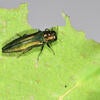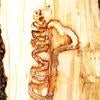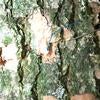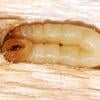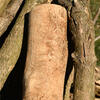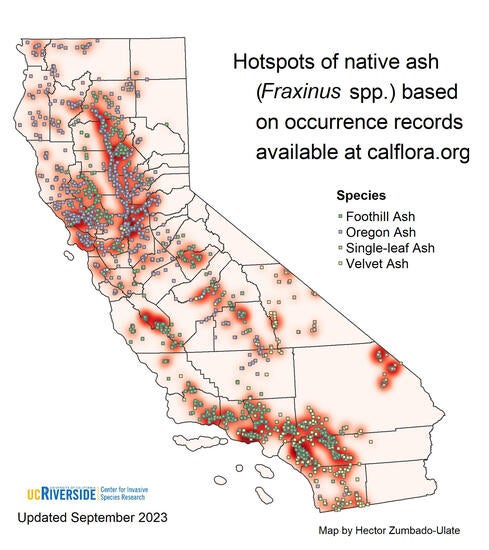Emerald ash borer, Agrilus planipennis
The situation: The emerald ash borer (EAB) is an invasive wood-boring beetle in the family Buprestidae that attacks ash trees (Fraxinus spp.) and certain other species in the family Oleaceae. Native to eastern Asia, EAB was first detected in the US in Michigan in 2002. Since then it has been recorded throughout the eastern US and Canada associated with significant damage to native and introduced ash species in natural forests and urban settings. Should EAB become established in California, it has the potential to dramatically impact native ash stands, ornamental plantings, and commercial olive production
Description: EAB adults are relatively small beetles, approximately ½” in length, with bright metallic-green wings. Females lay dozens of eggs in or under the bark on trunks or branches. After eggs hatch, the larvae tunnel into the tree to access vascular tissues. Larvae are light colored, approximately 1.5” in length, and have distinctive bell-shaped segments compared to more rectangular-shaped segments in related beetle species. EAB remains within the tree through pupation, after which adults exit leaving behind characteristic D-shaped emergence holes. Based on observations from the eastern US, adults begin to emerge in the Spring and can be active through late summer, with peak activity occurring in early Summer
Damage: Adult beetles feed on foliage, but don’t appear to cause significant damage compared to larvae. Larvae feed on phloem vessels, forming galleries in the sapwood, which compromises the tree’s ability to transport nutrients. Continued larval feeding results in defoliation, canopy dieback, and eventually tree death. The most pronounced declines likely occur in trees that are already stressed, but EAB can attack healthy ash trees. It’s host range includes several species of ash (Fraxinus spp.), and certain other species in the family Oleaceae, including olive (Olea euroapea) and fringe tree (Chionanthus spp.)
EAB has killed millions of ash trees in the US since it was introduced in the early 2000s. Ecologically, such mass die-offs may change forest structure and dynamics, alter ecosystem processes, and affect species that interact with ash trees as part of their life cycle. Economically, EAB has directly impacted the forestry and wood manufactured products industries by reducing yields, and has indirectly impacted property owners by lowering the aesthetic value of land. Local and state governments have devoted tremendous resources toward the treatment and removal of trees in affected areas
In California, EAB threatens common ornamental ash species in residential areas, multiple native ash, and agriculturally important trees. For example, research has shown the native Oregon ash (Fraxinus latifolia), which is widely distributed from the northern Coast Range through Sierra Nevada, to be highly susceptible. Moreover, although widespread damage has not been observed in the field, research indicates that olive trees are susceptible to this beetle
Distribution: The native distribution of EAB includes Japan, the Korean Peninsula, Russia, Mongolia, and northern China. In Europe, EAB has spread into western Russia and Ukraine and is expected to arrive in Central Europe in the coming years. After initially being detected in North America in Michigan, EAB has subsequently been recorded throughout much of the eastern half of the US and in five Canadian provinces (Manitoba, New Brunswick, Nova Scotia Ontario, and Quebec). Most recently, EAB was detected on the West Coast of the US in Oregon in June 2022
Management: Effective management or containment of EAB has proven challenging and costly, often relying on a combination of tree removal, insecticide treatments, and biological control. For trees showing severe damage, control measures have limited effectiveness and tree removal is recommended. For trees showing mild symptoms, soil applications of systemic insecticides can protect against further EAB damage and slow infestation of neighboring trees. Biological control may be an important element of EAB management. In the eastern US, native woodpeckers readily attack later larval instars. Indeed, evidence of woodpecker feeding may be a useful indicator of EAB infestation. Multiple species of native wasps, and at least one introduced species, are reported to parasitize EAB larvae in the US. Researchers are exploring whether additional parasitoids from EAB’s native range should be imported to improve biocontrol. Researchers are also investigating the effectiveness of and application methods for entomopathogenic fungi.
What to do: Although EAB has not been recorded in California, its occurrence in Oregon increases the risk of its introduction. Although EAB has modest natural dispersal ability, like other wood-borers, it can be transported within infested wood. Avoiding long-distance movement of firewood is an important step in mitigating the spread of this invasive beetle. Early detection is critically important for responses to invasive species.
Center for Invasive Species Research, University of California Riverside
Text provided by Matt Daugherty, Assistant Extension Specialist at University of California, and Hector Zumbado-Ulate
Photos provided by Jian Duan, USDA ARAS
Distribution map created by Hector Zumbado-Ulate
